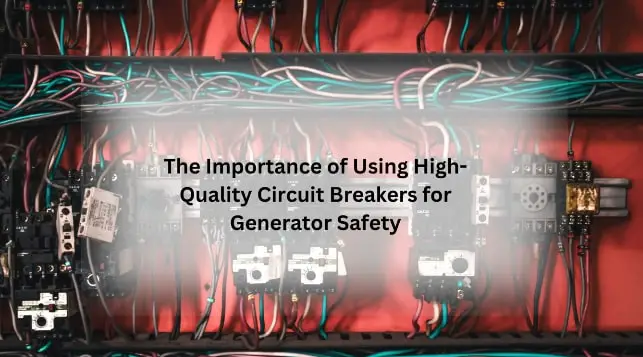As an Amazon Associate, we earn from qualifying purchases. This does not affect the price you pay or the quality of the products you buy. For more information, please read the full affiliate disclosure here.
Are you tired of experiencing frequent power surges or electrical devices getting fried because of unstable voltage output from your generator?
If so, you’re not alone. Many people face similar issues, but the solution lies in understanding the role of a generator voltage regulator.
A generator voltage regulator is an essential part that ensures your generator produces a stable and safe voltage output that meets the load requirements.
It regulates the voltage produced by the generator, which is critical for the proper functioning of electrical devices. However, a malfunctioning voltage regulator can cause electrical devices to fail or even damage the generator itself.
Hence, in this article, we will delve into the world of generator voltage regulators. We’ll discuss the different types of voltage regulators, how they work, and how to adjust and troubleshoot them.
And before you finish reading this article, you’ll have a better understanding of how to maintain and optimize the performance of your generator’s voltage regulator, ensuring that your electrical devices remain safe and functional.
What is a Generator Voltage Regulator?
A generator voltage regulator is a device that regulates the output voltage of a generator by controlling the amount of voltage that goes into the field winding of the generator. The voltage regulator ensures that the generator produces a stable and safe voltage output that meets the load requirements.
Types of Generator Voltage Regulators
There are different types of generator voltage regulators, including:
1. Automatic Voltage Regulator (AVR)
An automatic voltage regulator (AVR) is the most common type of voltage regulator used in generators. The AVR works by monitoring the output voltage of the generator and adjusting the voltage by controlling the amount of excitation to the generator field winding. It ensures that the output voltage remains within a safe and stable range, even when the load varies.
2. Capacitor Voltage Regulator
A capacitor voltage regulator is another type of voltage regulator that uses capacitors to regulate the output voltage of the generator. The capacitor voltage regulator works by controlling the excitation current that flows through the field winding of the generator. The voltage regulator adjusts the excitation current by changing the capacitance of the capacitors.
3. Transformer Voltage Regulator
A transformer voltage regulator uses transformers to regulate the output voltage of the generator. The voltage regulator works by adjusting the transformer tap settings to control the amount of excitation to the field winding of the generator.
How Do Generator Voltage Regulators Work?
The function of the voltage regulator is to maintain the output voltage of the generator at a stable and safe level.
The voltage regulator works by controlling the amount of excitation applied to the field winding of the generator. The amount of excitation determines the amount of voltage that the generator produces.
Furthermore, it uses a feedback system to monitor the output voltage of the generator. The feedback system compares the output voltage to a reference voltage and adjusts the excitation to the field winding to maintain the output voltage at a constant level.
Making adjustments in real-time to ensure that the output voltage remains within a safe and stable range.
Benefits of a Generator Voltage Regulator
A generator voltage regulator provides several benefits, including:
- Stable and Safe Voltage Output: The voltage regulator ensures that the generator produces a stable and safe voltage output that meets the load requirements. This prevents damage to electrical devices and protects people from harm.
- Improved Efficiency: The voltage regulator improves the efficiency of the generator by reducing the amount of power that is wasted.
- Increased Lifespan: The voltage regulator increases the lifespan of the generator by preventing overloading and overheating.
How to Test a Generator Voltage Regulator
Testing a generator’s voltage regulator is important to ensure that it is working correctly.
To test the voltage regulator, you will need a voltmeter. Follow these steps:
- Connect the voltmeter to the generator’s output terminals.
- Start the generator and let it run for a few minutes to stabilize.
- Measure the output voltage using the voltmeter.
- Increase the load on the generator and measure the output voltage again.
- If the voltage remains within a safe and stable range, the voltage regulator is working correctly. If the voltage is too high or too low, there may be an issue with the voltage regulator.
Another way to test the voltage regulator is to check the voltage at the field winding. To do this, follow these steps:
- Disconnect the generator from the load.
- Remove the generator cover and locate the voltage regulator.
- Locate the field winding connections on the generator and connect the voltmeter to the field winding.
- Start the generator and measure the voltage at the field winding.
- Adjust the voltage regulator and check the voltage at the field winding again.
- If the voltage at the field winding is not within the specified range, there may be an issue with the voltage regulator that needs to be addressed.
How to Troubleshoot Generator Voltage Regulators
If you are experiencing issues with your generator voltage regulator, there are a few things that you can check to troubleshoot the issue:
- Check the connections: Make sure that all connections to the voltage regulator are secure and free from corrosion or damage.
- Check the fuses: Check the fuses in the voltage regulator and replace any that are blown.
- Check the brushes: Inspect the brushes in the generator and replace any that are worn or damaged.
- Check the wiring: Inspect the wiring in the generator and voltage regulator for any damage or corrosion.
- Replace the voltage regulator: If all other troubleshooting methods fail, you may need to replace the voltage regulator.
Don’t Relent
A generator voltage regulator is a critical component that regulates the output voltage of the generator to maintain a safe and stable voltage level.
The voltage regulator ensures that the generator produces a stable and safe voltage output that meets the load requirements.
Whenever it has an issue or develops one, don’t relent and find all means you can troubleshoot and fix it. If you can’t, you can contact a professional for help.
If you’re enjoying our content on generators and want to stay in the loop, we’d love for you to join our email list. You’ll be the first to know about new posts, updates, and exclusive offers. Just enter your email below and become part of our community today.
Other Articles You May Enjoy!
🔌 Generator Tools & Social Hub
Maximize your generator knowledge! Use our calculators and join our community for expert tips:
Stay connected for updates and exclusive content:
📘 Facebook Page 🐦 X (Twitter) 📌 Pinterest 🔒 Private Facebook GroupDiscover more from Generator Hacks
Subscribe to get the latest posts sent to your email.






